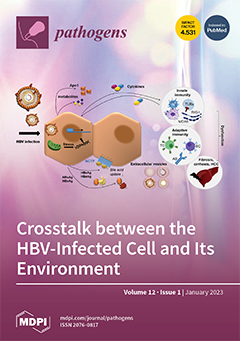In this study,
Listeria isolates (214) were characterized as follows:
L. innocua (77.10%),
L. monocytogenes (11.21%),
L. welshimeri (5.61%),
L. grayi (1.40%),
L. seeligeri (0.93%), and L. species (3.73%) that were not identified at the species level, from beef and beef based products
[...] Read more.
In this study,
Listeria isolates (214) were characterized as follows:
L. innocua (77.10%),
L. monocytogenes (11.21%),
L. welshimeri (5.61%),
L. grayi (1.40%),
L. seeligeri (0.93%), and L. species (3.73%) that were not identified at the species level, from beef and beef based products from retail and farms in Mpumalanga and North West provinces of South Africa. MLVA was further used to type
Listeria innocua isolates (165) and
Listeria monocytogenes isolates (24). The
L. monocytogenes isolates were also serogrouped using PCR. The MLVA protocol for
L. monocytogenes typing included six tandem repeat primer sets, and the MLVA protocol for
L. innocua included the use of three tandem repeats primer sets. The
L. monocytogenes serogroups were determined as follows: 4b-4d-4e (IVb) (37.50%), 1/2a-3a (IIa) (29.16%), 1/2b-3b (IIb) (12.50%), 1/2c-3c (IIc) (8.33%), and IVb-1 (4.16%). MLVA could cluster isolates belonging to each specie,
L. monocytogenes, and
L. innocua isolates, into MLVA-related strains. There were 34 and 10 MLVA types obtained from the MLVA typing of
L. innocua and
L. monocytogenes, respectively. MLVA clustered the
L. monocytogenes isolates irrespective of sample category, serogroups, and geographical origin. Similarly, the
L. innocua isolates clustered irrespective of meat category and geographical origin. MLVA was able to cluster isolates based on MLVA relatedness. The clustering of isolates from farms and retailers indicates transmission of
Listeria spp. MLVA is an affordable, simple, and discriminatory method that can be used routinely to type
L. monocytogenes and
L. innocua isolates.
Full article






